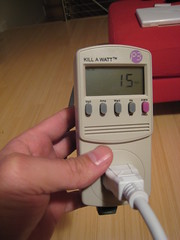OK so it is really the Miami Museum of Science Exhibit on electricity safety. But shouldn’t it be Frankensteen?:
http://www.miamisci.org/af/sln/frankenstein/index.html
:}
With lessons like this:
What is young Dracula doing wrong? If you guessed “using a hair dryer near water” you’re right!
Hair dryers and water don’t mix, and can be very dangerous! Never use a hair dryer near water and never place a hair dryer in water.
If you see a hair dryer or any other electrical appliance in or near water, stay away and go tell your parents or an adult!
Remember: Electricity and water don’t mix!
:}
And messages like this:
What is the young Mummy doing wrong? If you guessed “putting something near a lamp” you’re right!
Lamps use electricity to make light and can get very hot! If things get to close to a hot lamp they can catch on fire!
Never place anything near or inside the lamp shade. The lamp shade acts as the lamp’s safety zone. Nothing should be inside this safety zone.
Remember: Lamps can get very hot! Never place anything near or inside the lamp shade.
:}
Wish they would have know that at GE when they first started making these:
January 31, 2005Oregon schools, warehouses and businesses will soon be getting a state safety warning about the potential danger of ultraviolet exposure from cracked metal halide lights.State officials said they will also notify the federal government about an unusual but very real danger of severe “sunburn” and irritated eyes that can come from such exposure.The warnings follow a November incident that left about 80 Lake Oswego teachers suffering a range of symptoms after being exposed to ultraviolet radiation from a cracked metal halide bulb burning in a school gym.It was similar to a 2000 incident in which several spectators at a junior high basketball game in Sutherlin suffered from sore eyes and skin rashes that resembled sunburn.An environmental specialist hired by the state estimated that those sitting directly under the cracked light in Lake Oswego would have received a full day’s exposure to ultraviolet radiation in just eight minutes.
Metal halide lights are common in large spaces because of the bright, white rays they emit.
But a 1980 federal Food and Drug Administration directive says only metal halide bulbs that self-extinguish when cracked should be used in places where people could be exposed for more than a few minutes, unless other safety precautions are in place.
The FDA also ordered that warnings be placed on the packaging of metal halide lights that don’t self-extinguish.
Last week, the Oregon office of the Occupational Safety and Health Administration concluded an investigation that found many school districts and other employers are not aware of the danger of ultraviolet radiation.
The Lake Oswego incident happened when a metal halide light in the Bryant Elementary School gym in Lake Oswego was struck by a volleyball Oct. 18. The district maintenance staff didn’t change the bulb because, although cracked, it was still emitting light.
But a four-hour teacher training session in the gym in November left many teachers with symptoms ranging from sensitive skin to burned corneas and temporary blindness.
Teachers union president Kathy Lundeen said although doctors told teachers their symptoms should soon subside, “more than a handful” of teachers are still suffering dry eyes and sensitivity to light more than two months after the incident.
“I don’t think anyone should have to go through what the employees have gone through here,” Lundeen said.
:}
A final one:
What is the young Wolf Man doing wrong? If you guessed “placing something on top of a power cord” you’re right!
Placing objects on top of power cords can damage them, causing power shortages or even fires!
Remember: Don’t place objects on top of power cords.
:}
But this is my favorite:
















